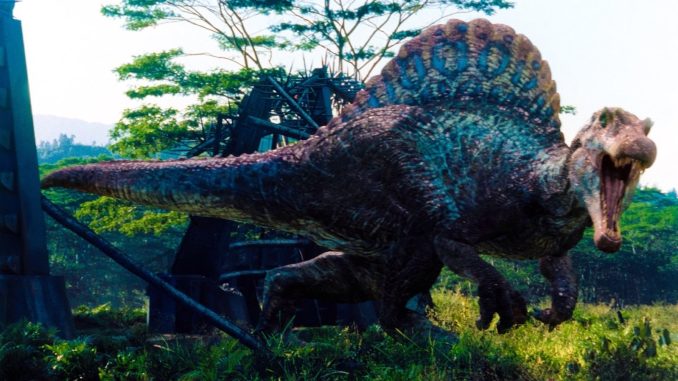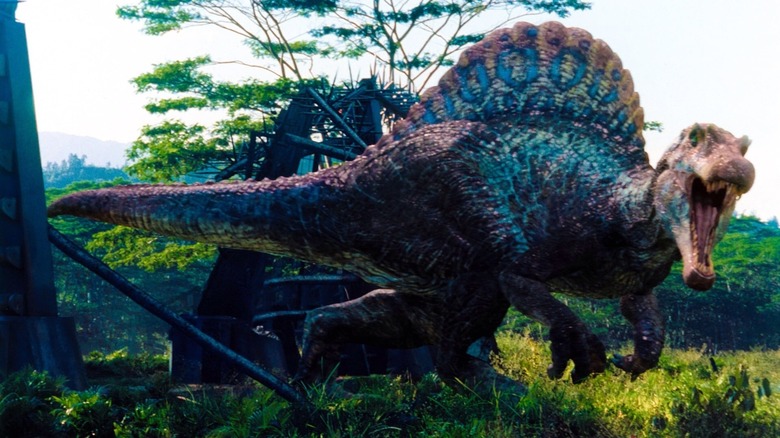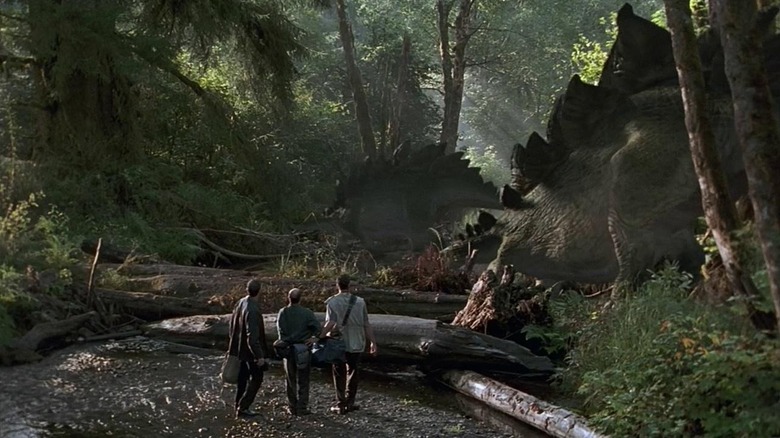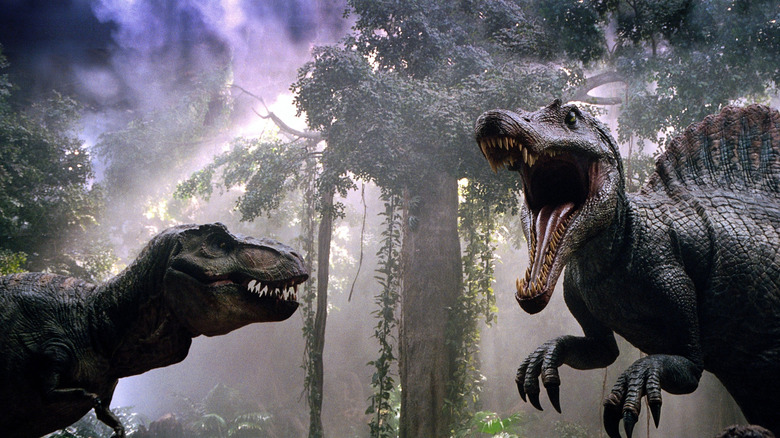
We may receive a commission on purchases made from links.
The “Jurassic Park” franchise has been going strong for more than 30 years, spanning six movies and multiple animated shows to date, not to mention quite a few video games and other supplemental media, like real-world theme park attractions. The franchise is far from done too, as this summer will see the release of “Jurassic World Rebirth.” Universal Pictures revealed in the first trailer for “Rebirth” that the film will feature multiple Spinosauruses, bringing back the fan-favorite dino for the first time in a long time.
Directed by Gareth Edwards, this latest installment centers on new characters and takes place on a new island, specifically the original “Jurassic Park” research facility. Because this is a new island, and not Isla Nublar where the actual theme park was, or Isla Sorna (aka Site B), where “The Lost World” and “Jurassic Park III” took place, the movie is going to feature different dinosaurs that we haven’t seen before, even if some of them are the same species. That means we’re not likely to see the Spinosaurus introduced in “JP3.” That does provide us the opportunity to revisit a long-burning question, though: Why wasn’t the Spinosaurus in “The Lost World?”
Practically speaking, director Steven Spielberg’s 1997 sequel “The Lost World: Jurassic Park” came out four years before 2001’s “Jurassic Park III,” and the idea of the Spinosaurus wasn’t even a thing yet. Director Joe Johnston brought audiences that hulking prehistoric beast to offer up something new to the franchise. But in the universe where these films take place, why didn’t Ian Malcolm or InGen encounter the Spinosaurus during their visit to Site B in “The Lost World?” Believe it or not, there is a very logical explanation within the canon of the franchise.
What happened between the events of The Lost World and Jurassic Park III?
The answer exists within official explanations regarding what happened between the events of “The Lost World” and “Jurassic Park III.” Before diving into the specifics, it’s important to point out that Isla Sorna is much, much bigger than Isla Nublar, as this image demonstrates. While this image is not necessarily canonical, it is based on canonical material, which we’ll get to in a moment. But the size of the island helps explain why these two movies look so different, despite taking place on the same island.
Various parts of Isla Sorna may well have different biomes, explaining the sheer number of types of terrain. It also explains why there are different dinosaurs, which operate in different territories. One theory was that the Spinosaurus had different territory than the T-rex family in “Lost World.” That theory falls apart in some ways when we consider the Spino fights (and kills) a T-rex in “JP3.” Still, this size difference is consequential.
The real answer lies within the in-universe website for the Dinosaur Protection Group, which launched ahead of 2018’s “Jurassic World: Fallen Kingdom.” This site contains a wealth of canonical knowledge via articles that help fill in gaps in the history of the “Jurassic” franchise not explained in the films. In the article “The Rise And Fall Of Masrani Global” from the website, it’s revealed that Masrani Global, the company that eventually launched an operational version of Jurassic World, conducted illegal cloning of dinosaurs beginning in the late 1990s.
“Recent revelations linked to the corruption of the Gene Guard Act by members of Masrani Global confirm the true cause – the introduction of illegally cloned animals on the island in 1999 caused a profound impact on the ecosystem.”
Before getting into the nuts and bolts of this bombshell, let’s break it down piece by piece. In the article “What Killed The Gene Guard Act?” from the DPG website, it explains what the Gene Guard Act actually is.
The Spinosaurus wasn’t alive during The Lost World
“The Ethical Negligence within Paleo-Genetic-Resurrection (ENPGR) Bill was passed under the new simpler title Gene Guard Act in 1997, as a response to the San Diego incident,” the article explains. “This Act would extend existing dinosaur specimens the same rights and protections as other endangered animals, as well as restrict any further access to the islands owned by InGen. It also prohibited any further cloning of new prehistoric fauna or flora by the company, which was committed (at the time) to upholding strict ethical regulations concerning the animals.”
In the world of the films, Masrani Global purchased InGen in 1998 after the fallout from the T-rex attack in San Diego at the end of “The Lost World.” Shortly thereafter, and ignoring the Gene Guard Act, several scientists went to Isla Sorna to conduct illegal experiments on illegal dinosaurs. This is referred to as “amalgam testing” in the articles on the site, and is known unofficially as Project Regenesis. The project was led by Dr. Henry Wu, the geneticist played by B.D. Wong in the films.
“It was unearthed that many of the dinosaur species present on Isla Nublar were new species that had been cloned before the [Gene Guard Act] was relaxed in 2003,” the articles also explain. These dinos were cloned between 1999 and 2003. Among the dinosaurs created illegally during this time? The Spinosaurus. An anonymous hacker known as JUR@55!_H@K3R revealed some damning information as a 2015 investigation into the events of 2015’s “Jurassic World.”
“The new species included: Ankylosaurus, Ceratosaurus, Corythosaurus, and Spinosaurus. All were abandoned on Site B, until the surviving animals were reportedly moved to Nublar to be housed as future attractions at Jurassic World…A number of these new animals had originally been reported by the survivors of the plane crash on Isla Sorna during the summer of 2001, but the information was quickly buried by ‘bribed officials.'”
Simply put, the Spinosaurus didn’t exist during the events of “The Lost World,” and it wasn’t until Alan Grant got stranded on Site B with the Kirby family in “Jurassic Park III” that people outside of Masrani became aware of its existence.
“Jurassic World Rebirth” hits theaters on July 2, 2025. In the meantime, you can grab the “Jurassic World Ultimate Collection” on 4K, Blu-ray, or DVD from Amazon.




Leave a Reply